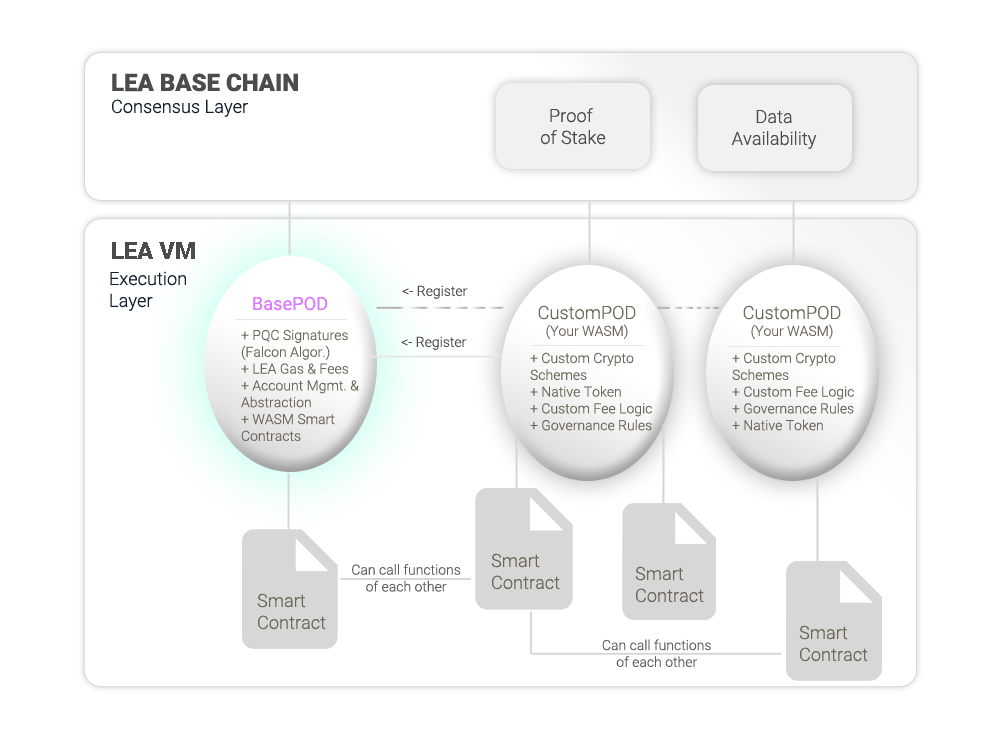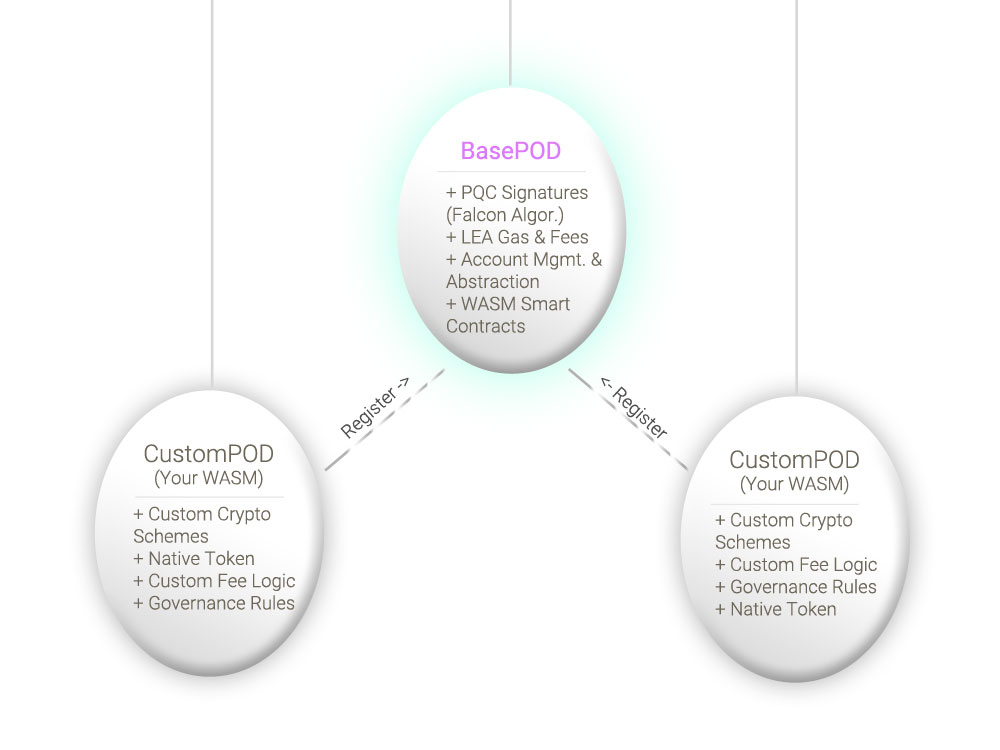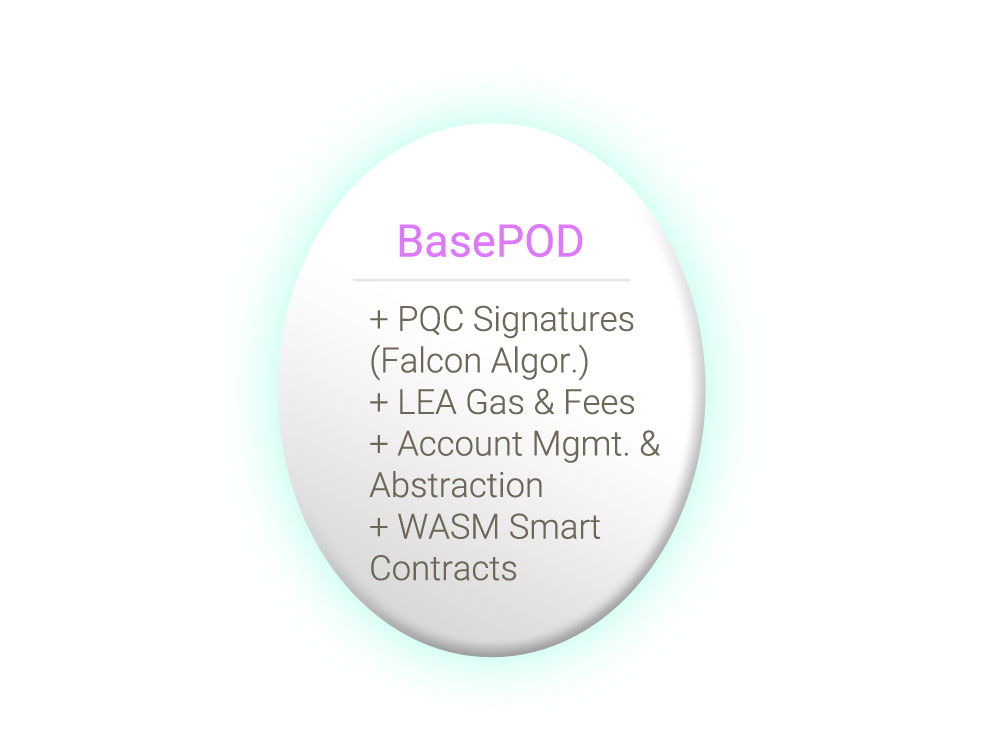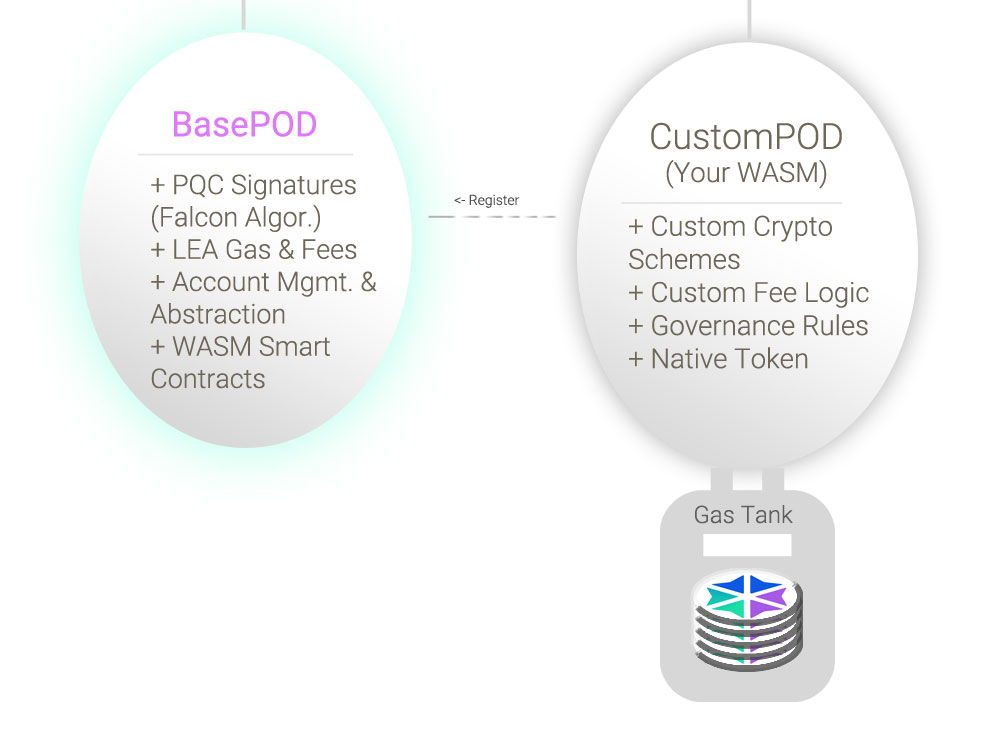The LEA Base Chain
Introduction
A Minimal, Secure, and Future-Proof Consensus Layer
The LEA Base Chain is the foundation of the entire LEA ecosystem. It’s a stateless Layer 1 consensus engine that provides one simple but critical function: ordering transactions and dispatching them to smart contract-based interpreters called Decoders.
Unlike traditional blockchains that execute all logic within the core protocol, LEA’s base chain does not validate, execute, or interpret transactions. Instead, it focuses entirely on:
- Transaction Ordering using a Proof of History-inspired mechanism
- Data Availability by recording all transaction envelopes permanently
- Dispatching transactions to Decoders (PODs) based on the included DecoderID
This minimal design makes the base chain lightweight, scalable, and nearly immutable, ensuring long-term security and reliability without the need for constant upgrades.
Designed for reliability, simplicity, and unbounded modularity
Key Characteristics
- Stateless & Execution-Agnostic
No balances, accounts, or smart contract logic are handled at the base layer. - Proof of History (PoH) Inspired
Efficient and tamper-proof transaction ordering with built-in timestamping. - Universal Dispatch Mechanism
Every transaction envelope includes a DecoderID, and the base chain forwards the payload to the matching smart contract Decoder. - Built for Sovereignty at Scale
By removing execution from the consensus engine, LEA enables thousands of independent logic layers (PODs) to coexist without contention. - Post-Quantum Security (PQC Ready)
The base protocol integrates a dual-signature model:-
Ed25519 for efficient day-to-day transactions.
-
Falcon-512 for high-value operations and long-term resilience.
This ensures quantum resistance from the start while preserving cryptographic agility—new PQC standards can be added via Decoders without hard forks
-
Programmable Object Domains — Fully Sovereign Execution Environments on LEA
What Are PODs?
PODs (Programmable Object Domains) are the core innovation of the LEA Blockchain.
They allow developers to launch self-contained, sovereign execution environments on top of the LEA Base Chain—each with its own rules, cryptography, tokens or coins and fee model.
Unlike traditional blockchains where all apps share the same execution engine and constraints, PODs give you complete control over how your environment works—without requiring any changes to the base protocol.
Cryptographic Logic:
Define your own signature schemes, post-quantum algorithms, or zero-knowledge proofs via your custom Decoder.
Fee Model:
Choose your own coin or token for gas payments, allow fee sponsorships, or go gasless. A $LEA-powered gastank ensures miners are still incentivized at the base chain level.
Native Coin & Economics:
Launch your own coin within your POD, independent of $LEA.
Governance & Permissions:
Build custom access rules, KYC logic, or DAO voting systems inside your execution model.
The Default Execution Environment on LEA — Secure, Standardized, and Post-Quantum Ready
What is the BasePOD?
The BasePOD is LEA’s first and foundational Decoder. It acts as the default execution layer for smart contracts that are not part of a custom POD and provides the basic infrastructure that every LEA transaction interacts with at some level.
While custom PODs define their own execution logic, the BasePOD offers a ready-to-use, post-quantum secure environment for developers who don’t need—or aren’t ready to deploy—a full sovereign POD.
Post-Quantum Cryptography (PQC):
All signature verification within the BasePOD uses quantum-resistant algorithms like SPHINCS+, ensuring long-term security from the start.
LEA Native Fee Logic:
Transactions under the BasePOD use $LEA for gas. This provides a stable, predictable environment for contract execution.
Account Abstraction & Key Management:
On-chain key rotation, recovery, and flexible account models are supported by default.
Smart Contract Execution:
Developers can deploy WASM-based smart contracts directly under the BasePOD without needing to define their own cryptographic or economic rules.
Your decision on what you prefer or need
BasePOD vs. Custom PODs
Smart Contracts under BasePOD:
Use standardized cryptography and pay fees in $LEA. Best for lightweight apps, early-stage prototypes, or teams that prefer simplicity.
Fee Model explained:
LEA’s architecture allows custom PODs to define their own native coins or tokens and fee logic, while still ensuring the base chain’s security through $LEA incentives. This is managed via a gastank mechanism:
✅ If the POD’s gastank is filled with $LEA:
The POD owner covers the base chain fees on behalf of users.
→ Users can pay transaction fees in the POD’s native coin or token.
→ The gastank pays $LEA directly to LEA miners (validators).
⚠️ If the gastank is empty or unfunded:
Users are required to pay their transaction fees in $LEA directly.
→ The POD’s native fee model is bypassed until the gastank is replenished.
This ensures that PODs can offer seamless, branded experiences with their own coin or token economics—without compromising the integrity of LEA’s consensus layer.
Custom PODs:
Register with the BasePOD, but do not share its execution logic. They define their own signature schemes, fee models, and native coins or tokens—but rely on a gastank (funded in $LEA) to cover the cost of base-layer transaction inclusion.
Important: All PODs register through the BasePOD for indexing and discoverability, but do not inherit or rely on its execution logic.
Cross-POD Smart Contract Communication with Seamless Integration
Interoperability & Reusability
One of LEA’s core strengths is its built-in interoperability across all Smart Contracts and PODs—no matter how customized or isolated their execution environments are.
Whether you deploy a Smart Contract under the default BasePOD or inside a custom POD with its own rules and token, you can freely call and interact with any other Smart Contract on the chain.
Unified Communication Across Domains
All contracts on LEA—regardless of where they are deployed—can:
- Invoke functions in other contracts
- Pass data and assets across POD boundaries
- Use standardized interfaces to maximize composability
This design ensures that while PODs maintain execution sovereignty, they are not siloed. Contracts inside a custom POD can call contracts in the BasePOD or any other POD—as long as permission rules allow it.
Reusable Infrastructure by Design
LEA is built for composability and reuse. Developers can build domain-specific infrastructure in a POD—and others can adopt or extend it without duplicating logic.
Example: Reusing a KYC POD for a Web3 Job Marketplace
The Setup:
- A KYC POD exists on LEA, offering a standardized identity verification system. Users can verify their identity once and receive a reusable KYC credential stored in a smart contract.
- A Freelance POD is deployed separately by another team to create a decentralized job marketplace, where users can post jobs, accept offers, and settle payments in a native token like $WORK.
How Reusability Works:
- User Verifies Identity Once
The user completes KYC verification via the KYC POD and receives a verifiable credential in the form of an on-chain record. - User Applies for Jobs in Freelance POD
When the user applies for a job in the Freelance POD, the application contract calls the KYC POD to check if the user is verified. - No Need to Rebuild KYC Logic
The Freelance POD doesn’t have to implement or manage identity verification—it simply reuses the standard KYC interface from the KYC POD. - KYC for Payments or DAO Access
Other unrelated PODs (e.g. a DeFi POD, DAO POD, or even a real estate POD) can also use the same KYC POD logic to grant access, issue loans, or enforce compliance—without redoing verification or duplicating contracts.
✅ Each POD remains sovereign.
✅ Smart Contracts remain composable.
✅ The entire network remains interoperable.
Benefits for Developers
Plug-and-play infrastructure: Build once, reuse everywhere.
Composability at the contract level: Leverage any existing POD or contract to extend your own application.
No lock-in: Custom cryptography and execution do not block interaction.
Optional isolation: PODs can restrict access when needed, but open interaction is the default.
Summary
LEA enables a shared execution ecosystem with sovereign boundaries. Developers can create isolated PODs for governance, compliance, or cryptography—but they don’t lose access to the wider network. Through standard interfaces and universal compatibility, every Smart Contract and POD becomes a reusable building block in a modular blockchain economy.
Let’s dive right in.
Plug Into Our API in Minutes
Get your first request live and see how easy it is to build on our platform.





